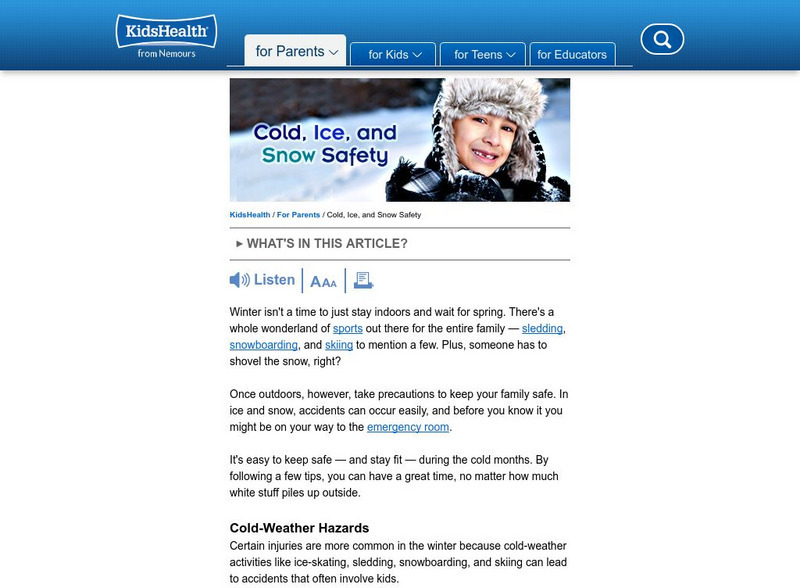University of Rochester
Common Cold – Self Care
When kids enter school, they often bring home new illnesses. Decode their symptoms, and help them to take care of themselves, with a fact sheet about the common cold. It delineates the symptoms one would experience as well as the signs...
Nemours KidsHealth
Colds and Flu: Grades 3-5
Two lessons from Kids Health Network aid in the prevention of cold and flu. The first instructional activity challenges scholars to read articles, discuss their findings, then create a PSA for proper prevention methods. The...
Curated OER
Echinacea No Cure all for Kids
Students look at real data and answer the question of whether or not they would recommend Echinacea to cure a cold. In this investigative lesson students describe whether the data supports the hypothesis that echinacea shortens the...
Curated OER
Colds and Germs
Learners determine how diseases are spread from one person to another. They investigate the importance of hand washing to reduce the spread of common colds and other diseases. They listen to teacher read alouds and complete an inquiry...
Curated OER
Good Drugs, Bad Drugs
Add a science experiment on medicine and drugs to your health lesson. After reading a paragraph on the difference between helpful and harmful drugs, kids choose which pictures of bottles they could find at a pharmacy. The last activity...
Nemours KidsHealth
Asthma: Grades 3-5
Young scholars discuss the health effects of asthma. In this asthma instructional activity, students answer questions about their own history with asthma or difficulty breathing. They create a pamphlet to go in a doctor's office to...
Food a Fact of Life
Soup-er!
Is there anything better than hot soup on a cold day? Kids prepare either vegetable chowder or minestrone soup in an activity that features the use of the stove top.
K12 Reader
Atmospheric Layers
In this two-part reading comprehension learning exercise, kids read a passage about the atmospheric layers surrounding the earth and then respond to a series of comprehension questions based on the passage.
Curated OER
Drugs Can Be Good and Bad
How can you tell which drugs are helpful, and which drugs are harmful? Use a health learning exercise in your kindergarten class to determine which drugs can make you healthy. They choose from a group of pictures that includes cough...
Curated OER
Hazards of Defrosted Food
Peas spoilage hot, peas spoilage cold: examine the bacterial growth on newly defrosted peas versus peas that have been defrosted for 24 hours. Using the session one questions in the "Microbes and Food Spoilage" PDF, learners will make...
National Association of School Nurses
Learn to Be Smart and Safe with Medicine
Begin educating young people on how to be smart and safe with medicine. Use a set of workbook pages to explore what symptoms are, uses for medications, how to read prescription and over-the-counter medicine labels, and who to trust when...
Centers for Disease Control and Prevention
Teach Mrs. Jones' Class about Microbes
During a biology activity, scholars research microbes, design a lesson plan using an outline, and present the activity to the class.
K5 Learning
The Coat
The moral of the story: listen to your parents! A concise reading passage introduces learners to Tom and the consequences of his choice to go out without a coat.
Curated OER
Latest Trend in Drug Abuse: Youths Risk Death for Cough-Remedy High
Students explore over-the-counter drug abuse. In this health journalism activity, students read the USA Today article titled "Latest Trend in Drug Abuse: Youths Risk Death for Cough-Remedy High", respond to discussion questions regarding...
Curated OER
Glitter Germs
Students discuss germs and where they come from. They participate in an experiment in which glitter is used to represent germs. They try different ways to get the glitter off, but they discover nothing works expect for washing their...
Curated OER
Eight Ways to Celebrate Fruit
Activities designed to incorporate the study of fruit into your classroom during National Fruit and Vegetable Month.
Curated OER
Epidemic!
Students research recent episodes when diseases like colds or flus spread through their school. It also asks them to think of public health measures that might stop a disease from spreading again.
Curated OER
Glitter Germs
Young scholars participate in a fun experiment involving glitter that teaches young children the importance of why they should wash their hands with soap and warm water. They explore that germs can easily spread if they don't properly...
Centers for Disease Control and Prevention
Understanding the Epidemiologic Triangle through Infectious Disease
Introduce infectious diseases and the epidemiologic triangle. A helpful resource describes the agent, host, and environment from the three vertices as well as the time factor, which is in the middle. Scholars complete a simple...
Curated OER
What Makes a Habitable Planet?
Students list conditions necessary for humans to survive. They then mix yeast with a nutrient broth consisting of warm water and table sugar in a plastic bottle, capping it with a party balloon and compare the factors within the bottle...
Curated OER
Science: Food Quiz
In this science: food quiz worksheet, students answer 20 questions, not interactively, about food, then scroll down to check their answers.
Curated OER
Understanding the Epidemiologic Triangle through Infectious Disease
Students examine the epidemiologic triangle. In this disease lesson, students discuss infectious disease as they study how they spread and discover their families' experiences with them. Students research Internet sites to complete...
Curated OER
Kids Health: Pneumonia
Use this site to learn all about pneumonia. Find out what pneumonia is, why some kids get it, how you know if you have it, what the doctors can do for you, and how to recover.
Curated OER
Kids Health: Cold, Ice, and Snow Safety
Playing in the snow is fun, but it can also be dangerous. KidsHealth website helps you learn about the importance of dressing for the weather to protect your body and health. This page also includes information about the dangers...























